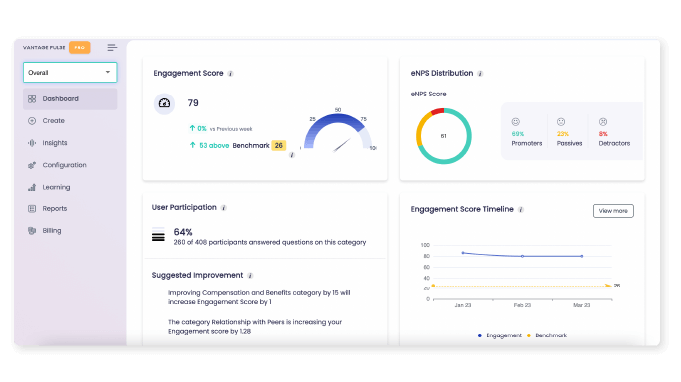Survey Savvy: 12 Tips On How To Conduct An Anonymous Employee Survey In 2024
Have you ever held back your true thoughts in a survey because you were worried about being identified or judged? You're not alone! Anonymous surveys offer a game-changing solution by giving you a voice without revealing your identity.
Anonymous surveys are more than just forms to fill out—they're tools that promote openness and honesty in workplaces, schools, and communities. In this blog, we'll explore how anonymous surveys benefit everyone and share tips on how to use them effectively.
Key Takeaways
- Why use Anonymous Employee Surveys?
- 12 Tips for creating Anonymous Employee Surveys?
- Examples of Anonymous Survey questions.
- Should Employee Engagement Surveys be Anonymous?
Why Use Anonymous Employee Surveys?

Anonymous surveys are great for getting honest opinions from employees. When answers are anonymous, people feel safe to speak freely without worrying about consequences. This allows companies to learn about real problems or issues that employees may not feel comfortable sharing openly. The honest feedback can help make things better at work, like improving policies, communication, and workplace culture. Anonymity gives employees a voice they can trust, which helps create a work environment that listens to their needs. Thus, these surveys identify areas for improvement and support overall employee well-being, contributing to a positive and engaging workplace culture.
Using anonymous employee surveys offers several important benefits like -
Open Communication
With the assurance of anonymity, employees are likely to share their opinions more openly without fear of reprisal, thus fostering a more open and trusting environment in the workplace.
Increase in Response Rate
The assurance of anonymity gives an increased sense of safety that leads to higher participation rates and more genuine responses
Honest Feedback
With the assurance of anonymity, employees are more likely to open up about more sensitive issues, giving employers a better understanding of the organization's pulse.
Helps Avoid Bias
Anonymity helps mitigate bias in survey responses, ensuring that feedback is based on genuine experiences and opinions rather than perceived consequences. These biases can affect the data from surveys. However, no previous knowledge about the participants or their backgrounds helps avoid biases in anonymous surveys.
Identify Issues
Honest feedback from anonymous surveys helps identify areas of improvement in various aspects of the workplace, such as leadership, communication, and organizational culture.
Employee Satisfaction
Ultimately, addressing issues raised through anonymous surveys can improve employee satisfaction, leading to higher retention rates and a more positive workplace culture.
Recommended Read: 9 Best Ways to increase Employee Survey participation rates
12 Tips for Creating Anonymous Employee Survey
Some factors need to be kept in mind while conducting any kind of anonymous survey.These factors can make a huge difference in how successful your anonymous surveys turn out to be.
So, if you're an HR professional or a leader, here are some must-know tips that'll turn your anonymous survey to be more effective.
Before the Survey
- Set Clear Objectives: Clearly define what you want to achieve with the survey. Whether it's improving company culture or identifying training needs, specific objectives will guide your survey design and analysis.
Example: Define whether your focus is on company values, employee satisfaction, or issues like communication or workload.
- Choose the Right Platform: Select a secure survey tool that ensures anonymity and data confidentiality. Consider platforms that allow for easy distribution and analysis of survey responses. Tools such as Vantage Pulse, CultureMonkey, and SurveyMonkey provide prebuilt templates and customization to suit your needs thus making survey planning a breeze.

Screenshot Source: Vantage Pulse
Example: Look for features like anonymous response collection, data encryption, and customizable survey designs.
- Communicate Honestly: Be transparent about the survey's purpose, how responses will be used, and the importance of honest feedback. Address any concerns about anonymity to build trust among employees.
Example: Explain that individual responses will be kept confidential and used only for aggregate analysis to improve the workplace.
- Emphasize Participation: Highlight the significance of employee input and how it will drive positive changes within the organization. Encourage all employees to take part, emphasizing that every opinion matters.
Example: Stress that the survey is a valuable opportunity for employees to voice their opinions and contribute to shaping the company's future.
Survey Design

- Mix Question Types: Incorporate various question formats to gather diverse insights. Use multiple-choice for quick responses, rating scales for quantitative data, and open-ended questions for detailed feedback.
Example: Use multiple-choice questions to assess general opinions, rating scales to measure satisfaction levels, and open-ended questions to capture specific suggestions or concerns.
- Keep it Concise: Limit the number of questions to maintain respondent engagement and ensure completion. Focus on essential topics that align with survey objectives.
80% average completion rate for surveys shorter than 7 minutes
Example: Aim for a survey that takes no more than 5-10 minutes to complete, prioritizing key areas of interest.
- Frame Questions Carefully: Use neutral and easy-to-understand language to prevent bias and ensure respondents comprehend each question. Avoid leading or ambiguous wording.
Example: Phrase questions in a straightforward manner, avoiding jargon or technical terms that could confuse respondents.
- Test and Refine: Start by trying out the survey with a small group of employees to uncover any confusing questions or technical problems. Use their feedback to improve and fine-tune the survey before reaching a larger audience. This process ensures that the survey is clear, effective, and user-friendly for everyone.
Example: Gather input from diverse employees to ensure the survey is clear, relevant, and user-friendly.
Read about How to Design an Employee Survey here.
During and After

- Set a Deadline: Establish a clear deadline for survey completion to encourage timely responses and facilitate efficient data collection and analysis.
Example: Communicate the survey deadline and send reminders to encourage participation and meet data collection timelines.
- Analyze Carefully: Review survey data objectively, focusing on identifying trends, patterns, and common themes rather than individual responses. Look for insights that align with survey objectives.
Example: Use data visualization tools to identify trends and correlations, highlighting key findings that inform decision-making.
- Act on Insights: Based on survey findings, develop an action plan outlining specific steps to address identified issues or areas for improvement. Share key outcomes with employees while maintaining anonymity.
Example: Communicate survey results transparently, outlining planned initiatives and demonstrating how employee feedback is being used to drive positive change.
- Iterate and Improve: Schedule regular anonymous surveys to track progress, measure the impact of implemented changes, and identify new areas for focus. Continuously refine survey design based on feedback and evolving organizational needs.
Example: Use feedback from previous surveys to inform future iterations, ensuring ongoing improvement and alignment with organizational goals.
Anonymous Employee Survey Questions

Creating effective anonymous employee survey questionsis essential for gathering valuable feedback while maintaining confidentiality. Here are some sample survey questions you can consider for your anonymous employee survey:
General Satisfaction
- On a scale of 1 to 10, how satisfied are you with your overall job at your organization?
- What do you like most about working at your organization?
- What areas need improvement within the company?
Communication and Leadership
- Do you feel well-informed about company goals and updates?
- How would you rate the effectiveness of your immediate supervisor/manager in supporting your work?
- Do you want to see anything specific from company leadership regarding communication or support?
Work-Life Balance
1.Are you satisfied with your current work-life balance?
2.Do you feel pressured to work beyond your regular hours?
3.Are there any workplace policies or practices that could improve work-life balance?
Team and Collaboration
- How well do you think your team collaborates and communicates?
- Do you feel valued and supported by your team members?
- Are there any challenges or conflicts within your team that need addressing?
Training and Development
- Have you had sufficient opportunities for professional development and training?
- Are there skills or knowledge areas you would like to develop further?
- Do your career goals align with your current role at the company?
Feedback and Recognition
- Do you receive regular feedback on your performance?
- How do you feel about the company's recognition and rewards system?
- Are there any specific instances where you felt your contributions were not acknowledged?
Workplace Culture
- How would you describe the workplace culture at your organization?
- Are there any aspects of the culture that need improvement?
- Are diversity and inclusion priorities at the company?
Health and Well-being
- Does the company provide adequate support for your physical and mental well-being?
- Are there any workplace stressors that need addressing?
- Do you have access to resources for maintaining a healthy work-life balance?
Suggestions for Improvement
- What changes or improvements would you recommend to make (Company Name) a better workplace?
- Do you have any ideas for enhancing employee morale or engagement?
- Is there anything else you want to share about your experience at the company?
Open-Ended Questions
- Is there any additional feedback or comments you'd like to provide anonymously?
- Do you have any concerns or issues you want to share confidentially?
- Is there anything else you would like to share about your overall experience working at the company?
When crafting your employee survey, consider the goals and objectives you want to achieve and ensure the questions are clear, concise, and relevant to your organization's specific context. Additionally, emphasize the anonymity of the survey to encourage employees to be honest and open in their responses.
Recommended Read: 55 Essential Employee Pulse Survey Questions For 2024
Should employee engagement surveys be anonymous?

DID YOU KNOW Anonymous employee surveys can achieve response rates upwards of 90%.
Based on the points discussed above, it is evident that anonymity in surveys promotes more honest, constructive, and representative feedback. This kind of openness and transparency is essential for organizations to drive positive change and make meaningful improvements.
Let's explore several key impacts of anonymous surveys:
Company Culture:
Anonymous surveys allow employees to candidly reveal problems in the company culture that they may otherwise feel uncomfortable raising, such as issues with management, communication breakdowns, discrimination or favoritism. This honest feedback sheds light on cultural blind spots and areas for improvement that leadership may have been unaware of.
Management Effectiveness:
Anonymous feedback on manager performance allows employees to share constructive criticism without fear of retaliation. Without worrying about repercussions, they can candidly point out issues like micromanaging tendencies, poor communication habits, lack of clear goal-setting, or inequitable treatment. This can provide valuable insights to help develop and support effective leadership.
Diversity, Equity, and Inclusion (DEI):
Surveys on DEI initiatives are often more successful when anonymous, as this encourages open and honest responses about experiences with bias, inclusion, and equitable treatment in the workplace.
Training and Development Needs:
Anonymity on training and skills development surveys enables employees to candidly assess their own knowledge gaps and learning needs, which can inform more targeted and effective training programs.
Work-Life Balance:
Anonymous surveys on topics like flexible scheduling, parental leave, and work-related stress can uncover important issues that organizations may not be aware of, allowing them to support employee well-being better.
Organizational Changes or Initiatives:
When rolling out new policies, programs, or other changes, anonymous feedback allows employees to share concerns, questions, and ideas without fear of consequences, allowing for a more successful implementation.
Finally
Anonymity fosters a safe and non-judgmental environment for survey respondents, leading to more accurate data collection and actionable insights. It empowers employees to voice their opinions openly, ultimately contributing to organizational growth and improvement across various facets of the workplace.
People are more likely to engage in anonymous surveys. Then, you are more likely to obtain accurate data on how employees perceive the workplace culture, employee experience, rewards and recognition program, and several other subjects.



















